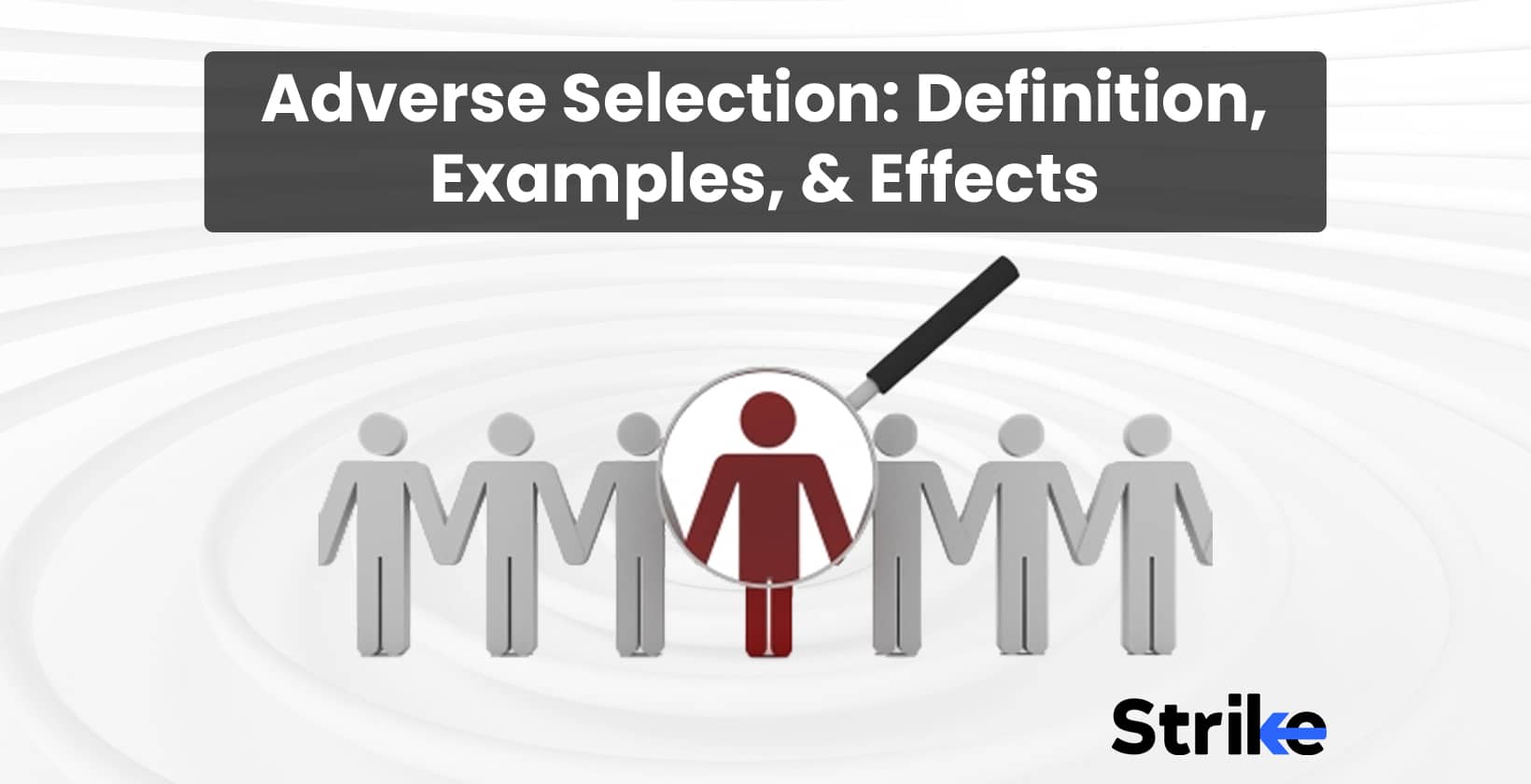
Adverse selection refers to the phenomenon that occurs when buyers and sellers have asymmetric information and this misinformation is exploited. The adverse selection causes seller to have more information than the buyer in most cases, and this can lead to negative consequences. Adverse selection is often seen in insurance markets, where those who are most likely to file a claim are also the ones most likely to purchase insurance.
Adverse selection functions to drive up the cost of insurance and decrease the quality of products offered. It can also result in a lack of competition in the marketplace. Examples of adverse selection include used car sales, health insurance, and the hiring process. Health insurance companies often face adverse selection when people with pre-existing conditions purchase insurance.
What exactly is an Adverse Selection?
Adverse selection, also called anti-selection is a term used to describe situations where one party in a transaction has more information than the other party. This lack of information can lead to negative consequences for one or both parties involved. The phenomenon can occur in many different markets, including insurance, employment, and used car sales. One of the most notable effects of adverse selection is that it can cause the cost of products, such as insurance, to increase.
Adverse selection also leads to reduced market competition, which negatively impacts consumers. For instance, adverse selection in economics arises from the asymmetry of information in trade, often leading to inefficiencies and financial losses. If you’d like to dive deeper into market dynamics, check out this guide on how stock prices are determined, which explores the factors influencing market valuations.
Suppose an investor is looking to purchase stocks in a company they believe will have a successful product launch. The company’s founder is aware that the product launch may not be successful and decides to sell their shares before the launch.
To better understand how adverse selection plays a role in trading, you can explore insights into investment portfolio management. It emphasizes strategies to mitigate risks associated with incomplete information.
How does Adverse Selection function?
Adverse selection functions by creating a situation where one party has more information than the other. This can lead to negative consequences such as increased costs and decreased quality of products.
Understanding the broader market implications of adverse selection and related challenges like systemic risk can provide a comprehensive perspective on how markets operate under imperfect conditions. In insurance markets, adverse selection often results in those most likely to file a claim purchasing insurance, leading to higher costs for insurance providers.
The phenomenon also results in a lack of competition in the marketplace. Adverse selection can occur in markets including employment and used car sales. It ultimately leads to decreased efficiency and outcomes in the market.
Underwriters have a role in adverse selection. They work to identify and minimize the risk of adverse selection by analyzing the information that is available. This involves reviewing medical histories or conducting interviews with potential policyholders.
The purposes of adverse selection are to identify situations where one party has more information than the other, to understand how information asymmetry impacts economic transactions, and to highlight the role of underwriters in mitigating adverse selection risks.
Consequences of adverse selection include increased costs for products such as insurance, decreased quality of products offered, lack of competition in the marketplace, decreased efficiency and outcomes in the market, and potential financial losses for those with less information.
What is an example of an Adverse Selection problem in real life?
One example of adverse selection in real life is the market for health insurance. People with pre-existing conditions are more likely to purchase insurance because they know they will need medical care. Insurance providers are aware of this and charge higher premiums to offset the higher costs of healthcare for these individuals. Below are two more examples of adverse selection.
Example of Adverse Selection in Economics
An example of adverse selection in economics is the used car market. Buyers of used cars are often concerned about the condition of the car they are purchasing, leading sellers to withhold information about the car’s condition.
The seller is often aware of issues with the car, such as a transmission that is about to fail, but will not disclose this to the buyer. The buyer ends up paying more for the car than they would have if they had known about the issues, leading to potential financial losses.
Example of Adverse Selection in Banking
An example of adverse selection in banking is the issuance of loans. Borrowers who are the riskiest are those most likely to apply for a loan. Banks and other lending institutions are aware of this and often respond by charging higher interest rates to offset the greater risk of lending to these borrowers. The result of charging higher rates is that borrowers who are less risky are discouraged from taking out a loan, leading to a decrease in economic activity.
What are the advantages of Adverse Selection?
Adverse selection is not advantageous but instead, it is a problem that can lead to negative consequences as previously discussed. It causes increased costs, decreased quality of products, lack of competition, and potential financial losses. The purpose of discussing adverse selection is to identify situations where information asymmetry exists and to understand how it impacts economic transactions.
What are the disadvantages of Adverse Selection?
Adverse selection leads to negative consequences, such as increased costs, decreased quality of products, lack of competition, and potential financial losses. Below is a detailed list of disadvantages.
Increased costs for products such as insurance
Adverse selection leads to increased premiums and costs in insurance products due to an inability of insurers to accurately assess risk in potential policyholders. This makes them charge higher premiums to compensate for covering high-risk individuals who are more likely to file claims and file them more often than others. Accessing affordable coverage becomes less accessible or affordable to low-risk individuals because of this, creating less diversity within risk pools overall and potentially less stable ones.
Reduced Quality of Products Offered
Companies struggle to uphold the quality of their offerings because of adverse selection. Higher-risk consumers tend to prefer lower-quality offerings, and low-risk consumers are dissuaded from participating in the market due to higher costs. Participation drops due to this dynamic, ultimately leading to decreased product quality as companies lack the incentive to improve offerings when their customer base primarily comprises high-risk clients.
Lack of Competition in the Marketplace
Adverse selection deters newcomers from entering a market, as established companies are already catering their pricing and product offerings to high-risk consumers. This lack of competition may create monopolistic or oligopolistic market conditions that limit consumer choice while potentially driving up prices.
Reduced Efficiency and Outcomes in the Market
Adverse selection compromises market participants’ ability to make optimal decisions based on accurate information, leading to suboptimal allocation of resources and reduced overall efficiency of markets. High-risk individuals will not disclose their true risks while low-risk ones are priced out entirely. Such information asymmetry leads to suboptimal allocation of resources as well as decreased overall efficiency.
Potential Financial Losses Due to Adverse Selection
Adverse selection results in significant financial losses for market participants who do not possess all available information regarding other participants’ risk levels. Insurers experience higher-than-expected claims due to the overrepresentation of high-risk policyholders.
Lenders encounter higher default rates if unable to accurately assess borrowers’ creditworthiness, potentially undermining trust in the market and leading to further market inefficiencies. These financial losses further diminish trust within it leading to further market inefficiencies that undermine trust within it resulting in further market inefficiencies being created which leads back into this cycle of market inefficiency being created again.
These consequences ultimately lead to decreased economic activity and have a significant impact on individuals and businesses alike. It is important to understand how adverse selection functions and to work to minimize its effects in order to promote a more efficient and fair marketplace.
How does Adverse Selection affect economics?
Adverse selection has a significant impact on economics as it leads to decreased efficiency and outcomes in the market. This can ultimately result in decreased economic activity. Adverse selection leads to negative consequences such as increased costs and decreased quality of products.
Is Lemon Problem and Adverse Selection the same?
No, the Lemon Problem is a specific type of adverse selection problem that occurs in the market for used cars. Potential buyers are uncertain about the quality of the product they are purchasing and sellers have more information about the true value of the car.
This information asymmetry can lead to a situation where buyers overpay for low-quality cars or avoid purchasing altogether, which can result in decreased economic activity. The Lemon Problem is a type of adverse selection, but adverse selection can occur in other markets as well.
Is Advantageous Selection the same as Adverse Selection?
No, advantageous selection is not the same as adverse selection. Advantages selection refers to situations where one party has more favorable information than the other, leading to a better outcome for that party.
Adverse selection, on the other hand, refers to situations where one party has more unfavorable information than the other, leading to a worse outcome for that party. They are opposite concepts with different implications for economic transactions.
What is the difference between Adverse Selection and Moral Hazard?
Adverse selection and moral hazard are two related but distinct concepts in economics. Adverse selection refers to situations where one party has more unfavorable information than the other, leading to a worse outcome for that party.
Moral hazard refers to situations where one party takes actions that increase the likelihood of a negative outcome because they are protected from the consequences of their actions. Adverse selection relates to information asymmetry, while moral hazard relates to the effects of incentives on behavior, if put simply.








![85 Common Stock Market Terminologies for Dummies [Updated List for 2026] 4 85 Common Stock Market Terminologies for Dummies [Updated List for 2025]](https://www.strike.money/wp-content/uploads/2025/04/Popular-Stock-Market-Terms-for-Beginners-Banner.png)










No Comments Yet.